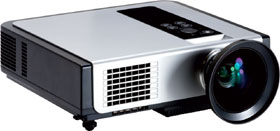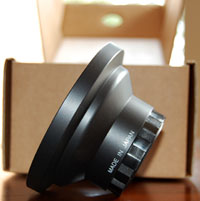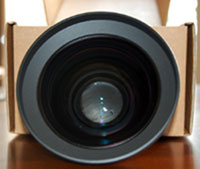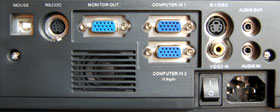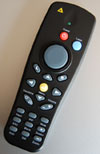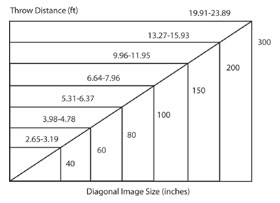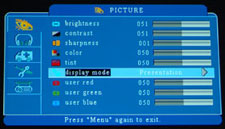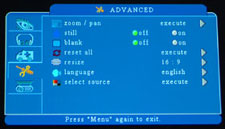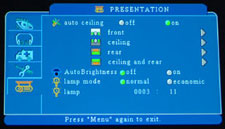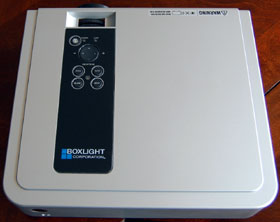 |
; |
Everybody loves a good two-for-one sale, but in the world of presentation projectors – or consumer electronics as a whole, for that matter – this has never been an option… until now. With the Boxlight CP755EW LCD projector, you have dual lenses: one that works with small spaces and one that’s made for larger spaces, so that no matter where you are and what the circumstances, you’ve got the prime gear to get the job done. FIRST IMPRESSIONS – Boxlight LCD ProjectorStyle & Appearance The Boxlight CP755EW LCD projector’s attractive styling and design is similar to their other CP series projectors (718E and 745ES) which feature a metallic silver color case with black accents. And like any good and self-respecting presentation projector, it weighs in at a modest 6.8 pounds (3.1 kgs.), and climbs up to 7.3 pounds (3.3 kgs.) when fitted with its handy short-throw lens. Size-wise, the dimensions of the CP755WE are (WxDxH): 12.1 x 10.5 x 3.7 inches (30.7 x 26.7 x 9.4 cm), and the height increases ever-so slightly to 4.6 inches (11.7 cm) with the short-throw lens attached. While some could argue that the CP755EW projector is slightly larger and heavier than the ultra-compact presentation projectors currently on the market, what certainly can’t be argued is this: you would essentially need two projectors to give you the projection range and versatility that you get with the CP755EW projector, thereby rendering the whole “slightly larger and heavier” debate a moot point.
Taking a closer look at this projector, the right-hand side of the CP755EW offers virtually all of the obvious features. The first thing you’ll see is the lens. With many Boxlight projectors, you’ll find the lens flush with the projector (if not a little back), but with the CP755EW, while the actual lens is still flush with the projector, there is a round, black metallic housing that just barely sticks out (about half-an-inch) so as to provide an attachment point for the short-throw lens. Just above the lens (on top of the projector) you’ll find a focus and zoom ring (1.2:1), as well as the hard-top buttons that include Power, Menu, Input, Auto, Blank, and the power and lamp light indicators. Still on the right side of the projector, but this time underneath it, you’ll find the cover for the projector’s air filter (Boxlight gives you a bonus air filter as well) and an interesting clear-plastic slot that can be used to store a… business card?! Indeed. If all your pockets and/or brief case/carrying case are otherwise occupied, Boxlight provides you with that much welcome alternative. Maybe not entirely necessary, at the very least it can be a rather neat conversation starter and veritable ice-breaker during those uncomfortable silences. With the right side all-but dominating the features end-of-things, the left-hand side offers a couple. There you’ll find an air vent (just across from the lens) that’s smartly angled away from the lens, and under that, half-way across the bottom, you’ll see the lamp replacement cover that can be conveniently accessed by unscrewing (naturally) the screw. From left to right on the front of the projector, you’ll also find two height-adjustable legs if you should need additional flexibility when projecting. Saving myself for the next section, I neglected to add that the feature-heavy right side of the CP755EW also contains all of the input connections. Getting Connected As per that uber-brief reference above, let’s now get into the connectivity offered by the CP755EW LCD projector. While being versatile enough to offer video inputs (S-Video and Composite), the bread and butter of any good presentation projector is the data-based inputs it can offer. In the case of the CP755EW, the inputs include: VGA (two), one for an external monitor connection, a USB which allows the projector’s remote control to function as a mouse when connected with a computer, an audio input for PC-based audio jacks, and an audio output when connecting with an external speaker system.
As mentioned, the connections panel is moved from the more standard rear of the projector to the right-hand side. I prefer this myself, as it allows for easier access, and you don’t have to leave as much space behind the projector to compensate for cable bulge. All in all, the CP755EW provides a nice collection of inputs, all clearly labeled and well spaced out. Remote Control PERFORMANCE – Boxlight LCD ProjectorSet-Up Once you’ve unpacked the Boxlight CP755EW LCD projector, it’s now time to get it all set up. As mentioned above, the CP755EW is essentially like having two high-end presentation projectors at you’re disposal. What will determine which version you use, is what type of space you find yourself in. This can usually go one of two ways. You’re in a large to extra-large space where having room is not an issue, or you’re in average to small-sized room that has various obstacles and space confinements involved. If you find yourself in the former (large/larger space), keep the short-throw lens at home and just use it as a standard, presentation projector. Alternately, if you find yourself in the latter situation (small/smaller space), simply attach the provided short-throw lens to the CP755EW and turn your projector into the short-throw projector of your dreams, capable of displaying a hundred inch-image in as little as seven feet (2.1 meters) back! As per the chart above, you can even throw a 60-inch image from less than five feet (1.5 meters) away, a 40-inch image at just over 2 and-a-half-feet (0.76 meters), and go really big by throwing a 200-inch image from a little over 13 feet (3.9 meters). That positively smacks of tremendous range and flexibility that you seldom – if ever – get with presentation projectors. Once you’ve determined which of the two lens configurations will be used, all of the remaining projector features I’m going to describe are universal to both. In terms of being able to get that projected image just right, along with the lenses, the focus and zoom rings, and the two adjustable front feet, the CP755EW offers a vertical keystone adjustment of plus or minus 30 degrees. And a real nice touch that Boxlight has implemented on this front is something called Auto keystone. This nifty feature, when enabled, automatically adjusts and corrects image distortion with just the simple touch of a button. Having to keystone a projector can be a hassle at the best of times, but when all that finger pushing is replaced by merely having to press a button, that’s something I can definitely get on board with. This useful option is available in the Setting menu, which also features another auto function, this one, however, is in relation to your sources. Called Auto search, this one finds your input source automatically so you don’t have to scan through the various inputs until you finally strike gold. Again, this is another really nice touch that helps expedite the process so you can focus on the nuts and bolts of your presentation as opposed to the mechanics of the projector. Speaking of menus, the CP755EW LCD projector features five user menus with a nice compliment of useful and practical features to give you exceptional control and range with your presentations or movie/video playback when you’re so inclined. The first menu, Picture, offers all the standard controls for Brightness, Contrast, and Sharpness (Color and Tint are available when in Video Mode). Additionally, there is a Display Mode feature which gives you six presets: Powerful, Video, Presentation, Natural, Cinema, and User. When User is selected, you’re given the ability to adjust the projector’s RGB (red, green, and blue) settings. As you can tell, for a projector that’s primarily geared towards business and academic presentations, the CP755EW in no way shortchanges those who’d like to use the projector for other purposes.
Some other notable user menu features worth noting is Auto Brightness and lamp mode. Both can be found in the presentation menu, and both allow you to tailor, regulate, and ultimately maximize your presentations. Auto Brightness (which can be turned on or off) detects and adjusts lamp light output accordingly based on the amount of ambient/bright light present in a room. So if you happen to be in an especially dark room where you don’t need all-out lamp power but forget to adjust your lamp mode, Auto Brightness does this for you, thereby extending the life of your lamp. That’s always a major plus. As mentioned, there’s also a feature in this menu called lamp mode. You have two lamp light output options here: Economic and Normal. In Economic mode, the projectors brightness output is 2400 ANSI lumens with 3000 hours worth of lamp life, and in Normal mode, the brightness level is 3000 ANSI lumens with 2000 hours in lamp life. In short, if you’re dealing with a large space and more-than average ambient light, you can take your lamp mode up to Normal and get that added bit of juice that the situation requires. Flipside, if the space is small and dark, Economic mode can be used and lamp life can be extended. These are tremendous options to have, because unlike some brands of projectors that can be quite obscure and mysterious with how much light their projectors output during regular operation (thereby leaving you in the dark as to how much lamp life you can expect out of your projector), the CP755EW puts it all right out there, front and center, so you’re always on top of things and never have to assume or infer. Another ultra-useful feature that you get with this projector is Unplug & Go. This allows you to virtually unplug and go when your presentation is done. That means no longer have to wait around for your projector to cool down before you power it off. In this super-fast, always-on-the-go world we live in, every second counts, and Boxlight has taken measures to accelerate the process, thereby allowing us to make better use of our time.
Out-Of-Box Picture Like any presentation projector that’s worth its while, I first tried the CP755EW with various laptop applications (PowerPoint, Word, Photoshop) using only factory default settings to see how it would perform. The short answer to this was very well. Text – in all its specific styles and type – looked vivid, crisp, and super-sharp. In terms of images and graphics, again, everything was very clear, detailed, and alive, and the advantages of LCD-based technology were on clear display. In all honesty, there wasn’t a whole lot to tweak by eye, but I did adjust a couple of things. In the Display mode of the Picture menu, I adjusted from Natural (default) to Presentation. This further enhanced an already clean and vivid image. I also changed the lamp mode from Normal (default) to Economic because the images were already so good that they didn’t require that extra bit of lumen output. If you happen to find yourself in a larger space with lots of ambient light, you may need that added bit of output, and having the ability to switch between the two depending on your environment is a terrific feature that the CP755EW LCD projector offers. Being that CP755EW is such a versatile projector that offers much in the way of user options, I also tried it out to see how it would perform via video playback. Out of the box, I tested it using a JVC DVD player with an S-Video connection, featuring the movie Death to Smoochy. A hallmark of this particular movie is bright, vivid colors that jump off the screen. To my surprise – and given the limitations of DVD in the wake of HD Blur-ray – the Boxlight CP755EW did a really good job. Images were vivid, colors were bright, and the overall quality of the details in both light and dark scenes was above average. I then made some adjustments by eye, using these settings:
In addition to the above, I kept the lamp mode at its default setting of Normal. I found that the images still maintained a nice, bright, vivid edge, but the color saturation was also improved, looking more realistic and textured, and less exaggerated and blown out. Contrast was also a little better, with even the particularly darker segments of the movie showing lots of subtle, nuanced details that only enhanced the richness of the image. Ultimately, for those looking for a High-def, Blu-ray carbon-copy out of their CP755EW projector, you won’t get it with any projector using standard DVD as your source and an S-Video connection as your cable. Having said that, with primarily a presentation-based projector that you may call upon for video playback from time to time, in the world of DVD or PC-based video modes, this is as good as it gets, offering above-average video quality that will satisfy most anyone. Calibration Calibrating the CP755EW was a simple and straightforward exercise, due in no small part to an intuitive and user-friendly menu system which offered a fine assortment of onboard options. With a projector that performed this well out of the box, I wasn’t surprised at how close the adjustments made by eye were to the final calibrated numbers. Additionally, white balance and an ideal color temperature of 6526K was easily established because red and blue color shifts were minimal and needed only the most modest of adjustments. When I re-watched the projected, PC-based applications, everything still looked clean and sharp and vivid, and I wasn't able to detect any noticeable differences in quality. As for video playback, all of the aforementioned positive attributes were still on display, but as a colleague perceptively noticed, the level of detail in the darker scenes was just that much better. For the main purposes of using the CP755EW LCD projector for computer-based presentations, a professional calibration isn’t necessary based on the improvements it will yield. And even though you can somewhat improve upon the contrast for video playback, it’s not a big enough reward for the intermittent times you’ll likely use it for such purposes. All in all, I’d just as soon recommend sticking with the multitude of options that the user menu offers (including six picture presets and independent RGB adjustments) when needing/wanting to make any image adjustments. FINAL THOUGHTS – Boxlight LCD ProjectorWhat if I was to tell you that there was a (legal) way you could essentially get two top quality, portable presentation projectors for the price of one. Would that be something you might be interested in? After your lightning quick and self-assured reply consisting of the word: “YES,” with the Boxlight CP755EW LCD projector, that’s basically the proposition that’s been presented to you. By offering dual lenses (which includes an attachable short-throw lens), you now have the ability to turn the CP755EW into a presentation projector that works equally as well in large spaces, as it does in smaller ones. Throw in two lamp modes that can not only conserve lamp life, but maximize performance by specifically tailoring lumen output to the precise surroundings you’re projecting from, and add a healthy dose of user menu options that make for better-than-average video playback, and lo and behold, a definite buy just managed to get a whole lot more definite.
DETAILED SPECIFICATIONS – Boxlight CP755EW LCD Projector
Highly Recommended
Video Projector Reviews
|
JVC DLA-X30 Review |
|||||||||||||||||||||||||||||||||||||||||||||||||||||||||||||||||||||||||||||||||||||||
|
Home • Projector Brands • Video Projector Reviews • Projector Resources • Contact Us
|
